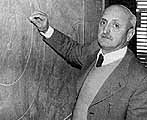| . |  |
. |
 Paris - September 30, 1999 - Almost everything known until now about the planet Mercury comes from three passes by NASA's Mariner 10 in 1974/75, which were inspired by Colombo's calculations. He suggested how to put that spacecraft into an orbit that would bring it back repeatedly to Mercury. The Italian scientist also explained, as an unsuspected resonance, Mercury's peculiar habit of rotating three times in every two revolutions of the Sun.
Paris - September 30, 1999 - Almost everything known until now about the planet Mercury comes from three passes by NASA's Mariner 10 in 1974/75, which were inspired by Colombo's calculations. He suggested how to put that spacecraft into an orbit that would bring it back repeatedly to Mercury. The Italian scientist also explained, as an unsuspected resonance, Mercury's peculiar habit of rotating three times in every two revolutions of the Sun.Meeting in Naples last week, the European Space Agency's Science Programme Committee recognised the achievements of the late Giuseppe Colombo of the University of Padua by adopting his name for the Mercury project now being planned. The mission to Mercury, now named after Prof. Colombo, is one of ESA's science programme "cornerstones". In the course of the comprehensive Horizon 2000 Plus review of the programme five years ago, it was identified by Europe's space scientists as one of the most challenging long-term planetary projects. Mercury is the least known of the inner planets. Its orbit close to the Sun makes it difficult to observe from a distance and hard to reach by spaceflight. As a result, big questions raised by the Mariner 10 flybys of a quarter of a century ago remain unanswered. "I am very pleased we have given the name of BepiColombo to our Mercury cornerstone. Bepi was a great scientist, a great European and a great friend; we could do no better than name one of our most challenging and imaginative missions after him" said Roger Bonnet, Director of ESA Science Programme. Scientists cannot claim to fully understand the origin and history of the Earth itself until they can make sense of Mercury.
A Surface Element dropped by BepiColombo will land near one of the poles of Mercury, where the temperature is milder. Here the instruments will include a camera, a seismometer, a detector for chemical elements, and a package for assessing the temperature, heat capacity, density and hardness of Mercury's "soil". The Surface Element is expected to operate for at least a week and the two Orbiters for about 12 months. When ESA began contemplating a mission to Mercury, the journey time was expected to be nearly four years, with a complex series of manoeuvres around Venus and Mercury designed to bring the spacecraft into an orbit similar to Mercury's. Now BepiColombo's journey will be cut to about 2.5 years with the aid of a solar-electric propulsion module, which ejects heavy xenon ions at high speed to provide a small but continuous acceleration over many months. Swingbys of Venus and Mercury are still part of the mission profile, and a chemical propulsion module will finally put BepiColombo's main spacecraft into orbit around Mercury. Personal notes about Prof. Colombo Giuseppe (Bepi) Colombo (1920-1984) was a mathematician and engineer of astonishing imagination, whose bald head and grey moustache were familiar in the corridors of both ESA and NASA. Apart from his work on Mercury, Colombo invented tethers for tying satellites together. As one of the initiators of ESA's mission to Halley's Comet he suggested its name, Giotto, but he died before that project was accomplished. At the University of Padua his work continues in CISAS, the Centro Interdipartimentale Studi ed Attivit� Spaziali "G. Colombo". In 1985 to commemorate this great scientist, ESA has created a "Colombo fellowship" to be granted to European scientists working in the fields of science explored by G.Colombo.
Mercury at SpaceDaily
|
| |||||||||
| The content herein, unless otherwise known to be public domain, are Copyright 1995-2016 - Space Media Network. All websites are published in Australia and are solely subject to Australian law and governed by Fair Use principals for news reporting and research purposes. AFP, UPI and IANS news wire stories are copyright Agence France-Presse, United Press International and Indo-Asia News Service. ESA news reports are copyright European Space Agency. All NASA sourced material is public domain. Additional copyrights may apply in whole or part to other bona fide parties. Advertising does not imply endorsement, agreement or approval of any opinions, statements or information provided by Space Media Network on any Web page published or hosted by Space Media Network. Privacy Statement All images and articles appearing on Space Media Network have been edited or digitally altered in some way. Any requests to remove copyright material will be acted upon in a timely and appropriate manner. Any attempt to extort money from Space Media Network will be ignored and reported to Australian Law Enforcement Agencies as a potential case of financial fraud involving the use of a telephonic carriage device or postal service. |